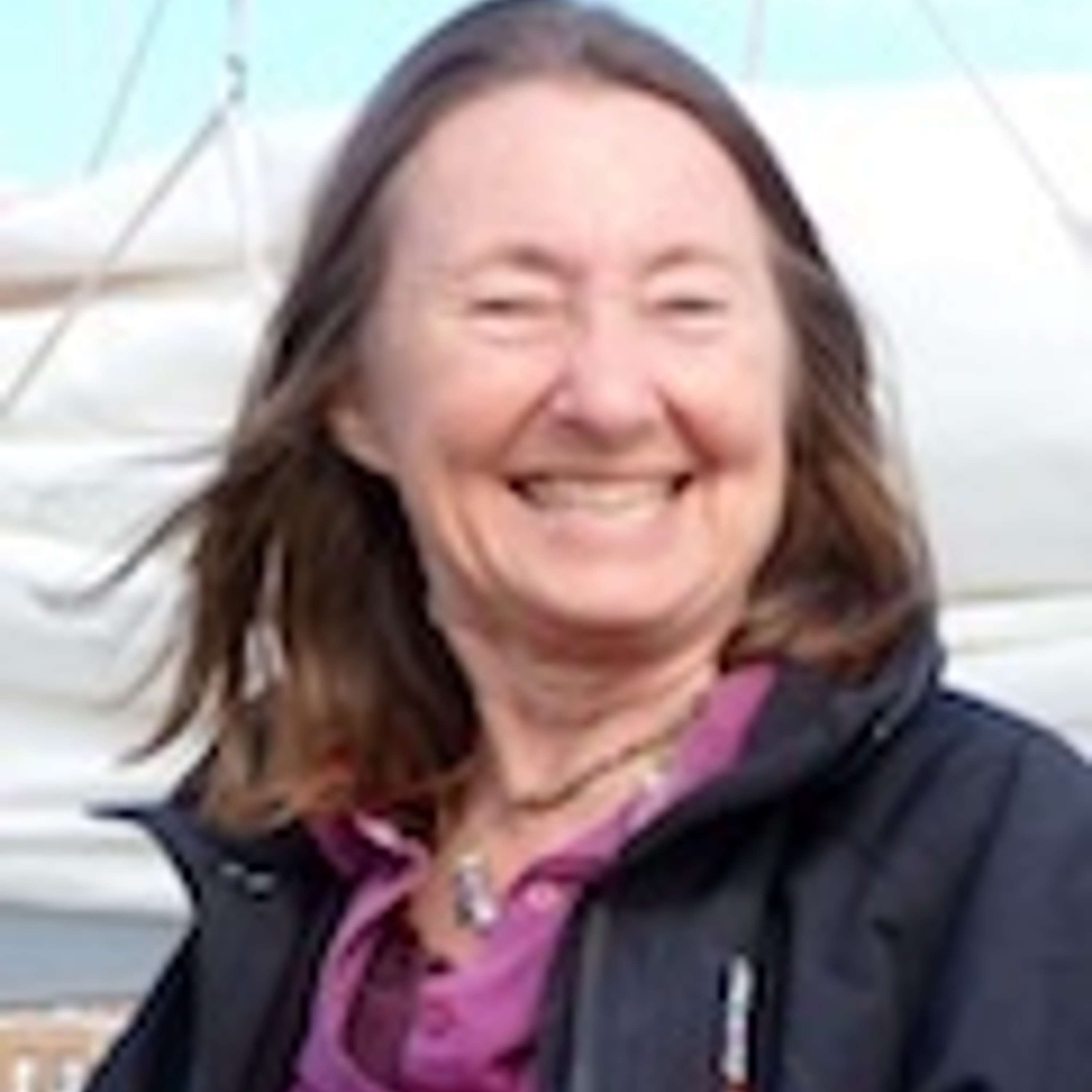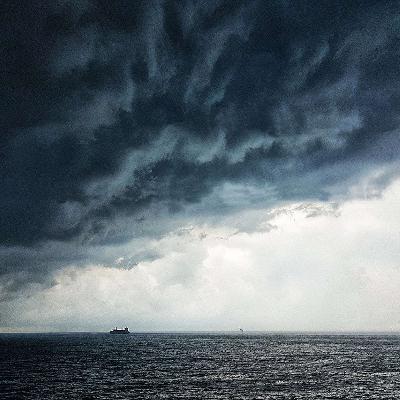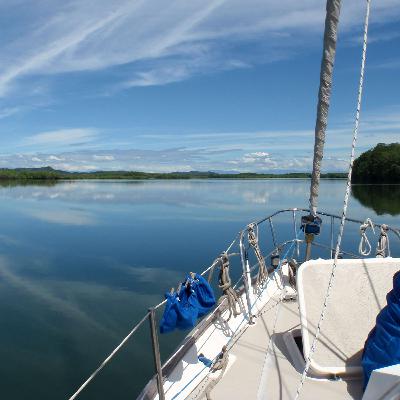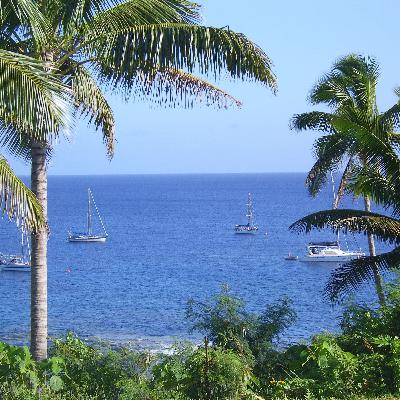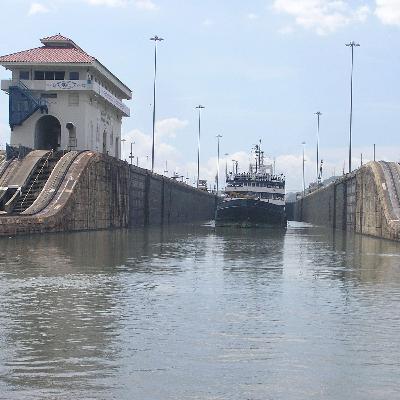Discover Turning Your Cruising Dreams Into Reality
Turning Your Cruising Dreams Into Reality

Turning Your Cruising Dreams Into Reality
Author: Jackie Parry
Subscribed: 18Played: 280Subscribe
Share
© 2019 SisterShip Training
Description
Practical, entertaining and informative stories.
From adventures around the globe on a small boat to practical tips and advice from international commercial and recreational sailors.
From adventures around the globe on a small boat to practical tips and advice from international commercial and recreational sailors.
42 Episodes
Reverse
Jeanne Socrates (at the time of writing) is back on her boat in Canada after an extended (land) stay in Australia (Covid). She is busy prepping her boat to sail to Australia. What drives Jeanne to keep sailing and traversing the long distances...?
Jeanne is a powerhouse of energy and smart thinking. “I am small I needed to think of the location of everything!” She has manuals for everything and has no problem repairing her engine while at sea. San Francisco and Alaska help her plan for single-handing, and upside down fixing the autopilot. Boat confidence is important as is taking charge of a vessel at every opportunity (not relying on someone else). Jeanne explains what drives her to go for records, the psychology of the why AND the psychology of losing her boat and almost her life!
Jeanne started her love of the water with surfing and dinghysailing. Soon she found out that although sailing is simple there is a lot to learn, Navigation, Col Regs, Passage Planning, weather.Hear about her first sailing experiences, her loves and losses.This is part one - part, two and three to follow
Imagine for a moment.... months at sea - 12 metre waves (great walls of water) being knocked down and sliding across the ocean top wondering if you'll come out of it.No one there physically to bounce ideas off.... reassure... give you a cuddle or a high five.Icebergs threatening and then icy rigging adding weight and stability problems... and on it goes..... Lisa is an extraordinary women.
Lack of sleep, knockdowns, icebergs, broken equipment, repairs at sea.... alone... the thought of her previous dismasting looming....
The scene is set on an 'open road' anchorage. Jackie and I sit, outside Bahia de Caraquez, Ecuador... the day we supposedly finish a two thousand, eight hundred nautical mile journey. This odyssey cruising the ITZC with all its associated calms storms and lighting and running before a hurricane warning - after 4 weeks are nerves are shattered.We have just missed the pilot to a safe harbour for 30 short minutes.
Distilling the essence of life at sea: It’s a love-hate relationship, a roller coaster. The journey becomes etched on our skin. Vibrant bruises match vivid sunsets. There are tremendous stresses on equipment as well as our bodies. We learn something new each day, about sailing and ourselves. Sailing the oceans isn’t easy, but offers magnificent rewards with perseverance. We whinge about the effort, but secretly we are glad, if it was easy, everyone would be doing it.
With nothing more to worry about than craving succulent roast chicken and gooey ice cream, we sliced through the ocean, enjoying the stuff dreams are made of. The concerns of motoring much of the way temporarily held at bay. Leaving Acapulco, Mexico for Isle de Cocos we were blessed with perfect sailing for four whole days. A8Bq5jMHpJx3QzMexAaG
With a charming mix of mega yachts and masquerading pirates onboard 7-metre sailing ghettos, San Diego is like a melting pot of poverty and prosperity. On the edge of America, with Mexico insight, here lies the stepping-off point for cruisers. San Diego is not a cruising ground as such with its king’s ransom fees and stifling regulations. It is a gateway to the Pacific Ocean. Late in the season, most cruisers are already in Mexico and beyond by now. But a few cruisers lurk, mainly small sailboats with no fixed agenda. Vessels that ‘live’ here are all pristine.
Chatting to my dad on Skype, he in England me in Ecuador, I told him how we planned to sail to Panama to collect our new sails. “You talk about it as though you are popping off to Supermarket” he laughed. With only 560 nautical miles to traverse, we thought the journey a breeze. But the trip grew to epic proportions, even before we started.Farewells are a continuous part of the cruising life that can pitch and roll the equilibrium that sailing bestows. After seven months anchored in Bahia de Caraquez, Ecuador, we had collected many friends; most we would never see again. But tipping the scales into a whole new level of sadness was the news.....
San Francisco is one of the most diverse and exciting cities we have had the pleasure to visit. It has a unique cultural tapestry and is a gay hub in more ways than one. Open water vistas are just waiting for a breath of wind to kick up into a brutal chop. Combined with a myriad of shallows, this recipe can cause even the seasoned sailor some difficulty.
We are 15 metres underground in a silent, echoing cave. Only the solemn plop of icy, freshwater can be heard, woven between our awed whispers. I take two big breaths, the chill of the encompassing sapphire water temporarily forgotten. Two metres down, with lungs bursting only moments after a big breath, I turn underwater to head through to the next cave. My thrashing arms and legs fight for propulsion and I feel stuck in a current that does not exist! Suddenly I see the torchlight from our guide in the next submerged cave and head to the surface, seeking much-needed oxygen. I am that close to being able to breathe again, I think I can just make it, when a firm hand reaches down and pushes my head back under. I am coming up too early, my soft head-on course for sharp, jagged rock. Fighting to withhold my panic I swim further along and the hand releases me, I break back into my world with the sweet smell of air. In reality, I have been underwater a few seconds and swam a few metres. “That was pretty easy” I grin.
First stop, Salinas, an over-nighter from San Diego, into a new marina. The entrance is narrow and has a distinct ‘east coast of Australia bar’ feel, creating a strong desire to make use of a rather large blindfold. The marina is reasonable at $30 US per night, but there is no running water directly to each slip. The key advantage is the assistance in the arduous process of checking in. A personal chauffeur ride to Ensenada (checking in port about 30 km south), helps smooth the historically renowned paperwork trail for Spanish speaking countries. The officials desired our company for the day, together with the entire contents of our bank account. We didn't really understand what was happening; the officials wrongly assuming they were dealing with intelligent and capable listeners. We wrongly thought everything was squared away. We smiled a lot, mimicked nodding dogs, filled out blank boxes with personal details and gave everyone we met money. We purchased a fishing licence for all persons on board (a requirement - we thought). With these licenses and new fishing gear, our first (and only) fish so far has cost about $300!
It stole our hearts, we wanted to stay. The island's charm, the people, the way of life appealed to us both, although we tried we couldn't. We did make the most of our stay - dancing, lunching, sharing, making new friends, even doing the laundry became a cherished memory!Join us in Aitutaki... where the women chew tobaccy.....
There are assorted methods to choose from to achieve the same thing. Whether at anchor, or in the mosquito-infested marina, there is a standard three days to complete all the paperwork. Once you have handed over all your dollars to anyone you meet, lied through your teeth, and signed your life away, you accomplish your “go through” date. Depending on how you reach this highly sought status, those three days can be effortless or can feel as though you have a three day pass into hell.
Behind schedule by three months (due to problems on terra firma not nautical) we hurriedly sailed 2,500 miles in six weeks to enable us to witness for ourselves why the San Blas is “a place to see”. We are also preparing for the Panama Canal experience, traversing the magnificent Pacific Ocean and heading home to Australia. We left Demopolis Alabama (which is approximately 200 miles north of New Orleans, up the TennTom River), then bumped and ground our way south towards the Grand Caymens where my Dad, Roy, patiently waited. “I felt a bit like Robinson Crusoe” he says, “waiting for my ship”. We prised him away from his luxurious hotel in exchange for a 33ft boat, disturbingly lacking in air con, maid service and fresh linen. Noel and I kept quiet about what the trip across Caribbean Sea offers, as my Dad has only sailed in protected waters. But Mother Nature took pity on us and presented a stalling low, enabling us to gain plenty of easting and rest for a night on Jamaica’s shores. The prevailing south easterlies are constant and strong across the Caribbean Sea. We took advantage of the gift of a suspended low, then rode on its back in a north easterly. A bouncy but speedy ride delivered us safely into the sanctuary of the San Blas islands.
A successful ‘Flopper Stopper’ principally has to do two things. (1) Sink easily. (2) Resist an upward force. One simple method is to have a weighted horizontal door. The ‘door’ opens on the way down (sinks) and ‘closes’ on the up lift from the halyards, a bit like a one-way valve. I have plans, in my head, for a stainless steel flopper. Sort of like a flat door in a four-sided door jamb, the whole thing being held by a halyard at each corner. That was not going to happen off the coast of Ecuador today.
With unemotional precision and no time for niceties the facts are disseminated to the awaiting crews. The silence buffets between the groups and the adrenaline starts pumping as a few of us peek over the wall to the building seas that await us. Many of us are scribbling down the information and start swaying from foot to foot in impatience of ‘getting out there and doing what we do’ – rescue!
It's easy to judge people's decisions, especially those on the water. Being a Skipper must not be taken lightly. That little piece of paper saying you are a licenced Captain carries a heavy responsibility. As a Skipper, you are responsible for everything and everyone on board. You are responsible even when you are not onboard - and even for your crew's actions.So don't judge decisions and don't criticise those who have a good understanding of the weather and how a handful of small issues can quickly escalate to a possible disaster...
We arrived Papeete the same day as Noel’s daughter, Mel arrived from Ayers Rock. We were nonchalant about the timing, only because we had not considered that marvellous innovation of the date line. After negotiating low flying aircraft, we chose the most popular anchorage, on the west of the island, south of French Polynesia’s Capital. Deep, clear water welcomed us in to a plethora of tightly packed boats. Supermarkets were a black-pearl throw away and the dusty, dirty city, just a twenty minute, bone-shaking bus ride. By this time in our voyage (over 35,000 nautical miles) I had become a little tired of amps, torque and bronze brushes conversations. The prospect of another woman onboard was exciting, I planned to get in depth about clothes, hair and, well anything but boats. We were both looking forward to playing host to our long awaited guest. On trawling through our emails that we read a note from Mel, “I arrive on the 21st July, not 22nd!” Four hours later, damp, dishevelled sailors and the disturbing disorder of Mariah’s innards met Mel.


